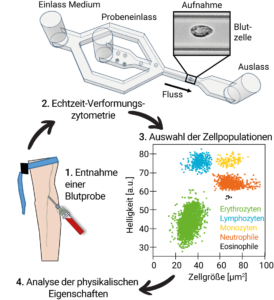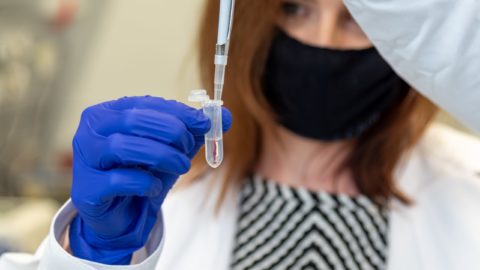Long-term changes to blood cells triggered by Covid-19 infection
An innovative approach
Using real-time deformability cytometry, researchers from the Max Planck Center for Physics and Medicine and FAU were able to prove for the first time that a Covid-19 infection causes significant changes in the size and stiffness of red and white blood cells, sometimes lasting several months. These findings may help to explain why some patients still suffer symptoms long after first contracting the virus (long Covid).
Shortness of breath, fatigue and headaches: some patients are left battling long-term side-effects of a severe Covid-19 infection for six months or even longer. We still do not entirely understand post Covid-19 syndrome, often referred to as long Covid. It has become apparent that the illness often impairs blood circulation, and may lead to dangerous congestion of blood vessels, restricting the transport of oxygen in the bloodstream. Blood cells and their physical properties have a key role to play in each of these phenomena.

and erythrocytes (image: MPI for the Science of Light/Guck Division)
Bearing this in mind, a team of researchers led by Markéta Kubánková, Jochen Guck and Martin Kräter from the Max Planck Center for Physics and Medicine, the Max Planck Institute for the Science of Light (MPL), FAU and the German Centre for Immunotherapy has investigated the mechanical properties of red and white blood cells.
‘We were able to measure significant and long-lasting changes to cells, both during the acute phase of the infection, and thereafter,’ reports Professor Guck, Chair of Biological Optomechanics at FAU and currently managing director of MPL. He explains that this has consequences for how Covid-19 is diagnosed and treated. The researchers have now published their findings in the Biophysical Journal.
They used a method they designed themselves called real-time deformability cytometry, RT-DC, which was recently awarded the prestigious Medical Valley Award, to analyse the blood cells.
This method involves sending blood cells through a narrow channel. The leukocytes and erythrocytes are stretched during the process. A high-speed camera then photographs every single one of them through a microscope, and special software determines the type of cell, its size and how severely deformed it is.
Using this method, up to 1,000 blood cells can be investigated per second. The advantage of the method is that is quick and the cells do not need to be dyed in a tricky and time-consuming procedure.
It is hoped that the method may act in future as an early warning system to recognise unknown viruses with the potential of triggering another pandemic.
The biophysicists from Erlangen were able to investigate more than four million blood cells from 17 patients currently in the acute phase of a Covid-19 infection, 14 individuals who have recovered from an infection and 24 healthy individuals.
Their findings showed that the size and malleability of red blood cells varied considerably more in those suffering from the disease than in the healthy volunteers. This indicates that the disease damages blood cells and may explain the increased risk of blood vessel congestion and blood clots in the lung. It may also explain why oxygen supply is impaired in those who have contracted the virus, as this is one of the main tasks carried out by erythrocytes.
As for white blood cells, the researchers found out that lymphocytes (white blood cells involved in the immune response) in Covid-19 patients exhibited a considerable decrease in stiffness, which may be an indication of a strong immune response.
The researchers observed a similar situation with neutrophilic granulocytes, a further group of white blood cells responsible for the intrinsic immune response. These cells remained dramatically altered even seven months after the acute infection.
‘We suspect that the immune cells’ cytoskeleton, which is responsible for determining cell function, has changed,’ explains Markéta Kubánková, lead author of the research article. In her opinion, real-time deformability cytometry could potentially be used routinely for diagnosing Covid-19, and even act as an early warning system in the future for detecting as yet unknown viruses with the potential of triggering a new pandemic.
Original publication
Markéta Kubánková, Bettina Hohberger, Jakob Hoffmanns, Julia Fürst, Martin Herrmann, Jochen Guck, Martin Kräter: Physical phenotype of blood cells is altered in COVID-19, Biophysical Journal, 2021, ISSN 0006-3495, doi.org/10.1016/j.bpj.2021.05.025.
